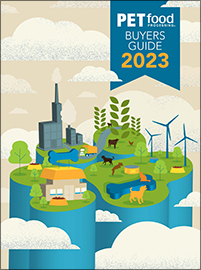This is the second article of a two-part series covering Packaged Facts’ recent “US Pet Market Outlook 2024” webinar on March 13. Find the first part of this series here.
KANSAS CITY, MO. — While inflation is impacting pet owners across the gamut, younger pet owners are particularly challenged by several economic factors, including credit card debt, student loan liabilities and an unfavorable housing market.
“With many [Millennials] living paycheck-to-paycheck, this lack of disposable income makes pet ownership a real challenge for them,” said Shannon Landry Brown, pet brand manager at Packaged Facts, a subsidiary of Freedonia Group.
This was one of several key takeaways from a March 13 webinar by Packaged Facts. In the webinar, Brown was joined by David Sprinkle, former publisher and research director of Packaged Facts, and David Lummis, president of Marigny Research Group, to discuss economic challenges likely to impact the pet ownership and spending behaviors of Millennials. The experts also dove into the various spending appetites of pet owners today, the rise of fresh nutrition, and how pet ownership trends in years to come may impact the industry’s growth.
For pet food specifically, 43% of both Millennial and Gen Z pet owners say high costs are a challenge for them, compared to 39% of Baby Boomer pet owners. Younger pet owners are also reporting spending less on pet products due to economic impacts, as well as seeking lower-priced and discounted products, at higher rates than the overall pet-owning population.
A lack of disposable income paired with increasing demand for solution-based nutrition comes as a catch-22 situation for younger pet owners in particular. As veterinary services become more expensive, the use of high-quality pet nutrition, functional treats and pet supplements are emerging as preventive measures to optimize pet health and wellness, according to Sprinkle. Lummis noted pet owners generally look to pet food as “the first line of defense” against health risks in their pets.
“…We’ve seen trends toward younger pet owners being especially likely to look for these kinds of solutions,” Landry Brown added. “Rather than turning to experts, they’d rather just take care of it themselves if they can.”
Spending on a spectrum
Of the pet owners who switched pet food products from January 2023 to January 2024, 32% of dog owners and 28% of cat owners traded down to a lower-priced option, Landry Brown shared. This is compared to 34% of dog owners and 44% of cat owners who switched to a higher-priced product, and 26% of dog owners and 24% of cat owners who transitioned to a similarly priced option.
However, data from Packaged Facts indicates pet owners are continuing to prioritize product quality when determining what pet care goods to purchase, with good value coming second, brand name coming third, and low price as the lesser priority.
“When we’re thinking about this trend, this shift to lower-cost pet care products and services, it’s important to note that pet owners may want to save money, but they don’t want to sacrifice quality to do so,” Landry Brown said. “They’re still looking for value for their dollar — they’re not looking for the cheapest option, they are still looking for high-quality items, just perhaps at a lower price point.”
As a shift toward lower-priced pet foods becomes more apparent in the marketplace, certain premium formats are expected to continue growing, according to Packaged Facts. These include fresh or gently cooked diets, human-grade pet foods, and freeze-dried and air-dried formats.
“Higher-income pet owners are likely the ones who use these products anyway, and this type of pet owner is a little less likely to let cost factor into their buying decisions,” Landry Brown explained. “Fresh, as we see it, is the ultimate super-premium positioning in the long-term, [and] something that’s going to last even through these economic challenges.”
Freeze- and air-dried pet food and treats, on the other hand, have been the target of recent M&A activity in the pet industry and pose a mess-free alternative to raw feeding, making them key formats to watch in the coming years.
Focus on fresh
While the fresh category is expected to grow and continue gaining market share in the coming years, Landry Brown, Sprinkle and Lummis briefly discussed some challenges that fresh brands have yet to master.
“[The fresh category] should continue to establish itself as a major category, along with dry and wet,” Landry Brown said. “Whether there’s room for several top-selling brands, at least in stores, who knows.”
She added Freshpet is “clearly the frontrunner in this category despite all the newcomers in the direct-to-consumer market for fresh pet food,” having set 2027 revenue expectations of $1.8 billion and growing its footprint across US households from 800,000 in fall 2020 to 1.2 million in fall 2023.
Lummis said he has observed some larger brands, including Blue Buffalo and Mars Petcare’s CESAR brand, that had announced new fresh offerings in recent years but have since pulled back on the category. Sprinkle noted this may have to do with logistical challenges unique to fresh pet nutrition offerings. Freshpet, on the other hand, leverages branded fridges in-store across various channels, including the mass channel, and the company’s distribution through Walmart stores has played a large part in the brand’s presence and availability.
For smaller brands entering the fresh space, Sprinkle noted the key opportunity would be establishing a large direct-to-consumer base to account for the “relatively limited space for fresh in-store,” he said.
While this shift from in-store to online is a major trend across categories, Sprinkle reiterated, he expects it to be especially prevalent in the fresh pet food space in the long term as smaller brands attempt to carve out their place in the market.
What the future holds
As pet owners have spent the last decade spoiling their pets, Sprinkle pointed out the industry has in turn been spoiled by favorable trends, some of which are not necessarily expected to continue over the next decade.
For example, the number of pet-owning households in the United States decreased 5% from 2019 to 2023, or by about 2,500 households, as older generations of pet owners fell off the industry’s radar and younger generations took their place. Interestingly, the tide of dog ownership has turned in favor of cats, with cat-owning households up 11% from 2018 to 2023, and dog-owning households down 6% over the same period.
Through 2030, the US dog and cat population is expected to remain relatively flat, with the number of cat-owning households projected to increase by 1.18% and dog-owning households to grow only by 0.66%. This is on track with an expected slowdown of US household growth overall through 2030.
“The bottom line is that pet owners are more likely to remain pet owners, and potential pet owners [are] more likely to become pet owners if the cost of pet ownership remains in reach for them,” Landry Brown added. “After all these years of heightened growth, we’ve gotten a little bit spoiled, but right now we’re thinking that the market is looking at a return to pre-pandemic spending habits [and] pre-pandemic growth rates in that 5% to 6% range.”
This is the second article of a two-part series covering Packaged Facts’ recent “US Pet Market Outlook 2024” webinar on March 13. Find the first part of this series here.
Keep up with the latest pet food trends on our Trends page.




